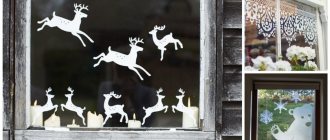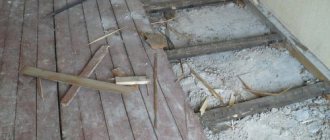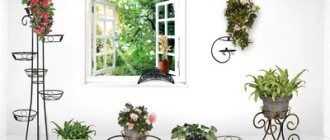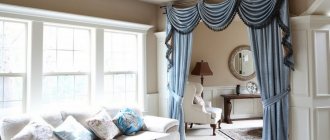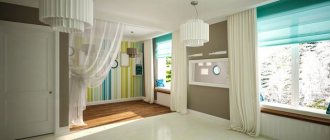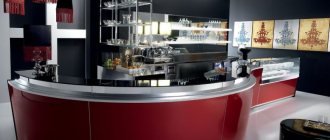Features of a forged metal rocking chair
The most common type of garden rocking chairs are chairs with a metal base. There are a number of reasons for this:
- High strength. The material can withstand loads of over 200 kg without the slightest damage;
- Plastic. Metal is capable of taking shapes of any complexity and intricacy;
- Long service life. A metal rocking chair will serve you for several decades;
- High quality appearance. Elements of forging or figured casting can turn garden furniture into a unique masterpiece;
- Availability of material while maintaining a reasonable price tag. If you have the necessary skills, you can make such a chair yourself. Please note that special equipment will be required. Purchased options will cost you more.
There are a number of not very pleasant features:
- Heavy weight. The rocking chair will need a solid base. On the ground it will sag, plunging into it with runners. You can partially reduce the total weight by making the seat from plastic or wood;
- Additional protection will be required. The material must be coated with a special varnish (not furniture varnish), an anti-corrosion compound such as VD (liquid key), metal paint or a special water-repellent wax. If this is not done, then very quickly the entire structure will become covered with rust stains. The protective coating will have to be updated regularly;
- Low mobility. Such furniture is not so easy to move.
Types of designs of forged rocking chairs
There is a wide range of models of forged rocking chairs, differing in the design of the base:
- Classic. Mounted on paired curved skids. The armrest is separate. Radius skids without a rear stop may cause them to tip over when rocking too hard;
- Viennese. The runners with armrests form a single arc;
- With bump stops. The runners at the front end at the level of the first supports, but the abrasions are very long. At the same time, their edge is bent down. This prevents tipping over, but causes sounds of hitting the floor at a large amplitude. If you stop suddenly, there is a risk of falling off the seat;
- Elliptical. The runners with the armrest are fused and made in the form of a continuous oval;
- 3 in 1. Skis are made with several edges. As you move, you can get a vertical rocking chair, a reclining position (swinging) or a lounger without rocking. You will have to turn it manually, or by sharply tilting your body. Very large;
- Pendulum mechanism. The runners are smooth and motionless. An arc is welded to their edges. Next, a mechanism consisting of 4 flat strips with bearings embedded in them is attached to the base. In this case, they are placed diagonally or in the shape of a trapezoid regarding the support. Swing type is inertial. Requires mechanical feed to start movement. The device allows you to equip the chair with a folding footrest.
Forged tables
Once upon a time, during the reign of luxury and sophistication, forged interior items were a mandatory attribute of every noble home. Strength and durability, combined with elegance and solidity, make forged tables popular today.
Interior items passed down from generation to generation have acquired the status of antiques over time. It is not difficult to guess that such specimens are very, very expensive. However, even in the modern world, the ancient tradition is alive and there are many masters of artistic forging who are ready to make a masterpiece of any complexity at your request.
Connoisseurs of real art, discerning buyers who want to pay tribute to traditions and at the same time become owners of modern, extraordinary pieces of furniture, turn to artistic metal forging salons. As a result, they get real works of art, because forging is art in its purest form. Despite the relatively high cost of such items, it is worth it.
Forged tables in the interior
Forged tables and chairs are completely independent interior details; their undeniable advantage is durability, versatility, elegance, and uniqueness.
Speaking about the versatility of forged tables, we mean that you can decorate a room of any style with such an item, be it modern, classic, art deco, country or even high-tech. You can order the production of a particular object according to your own design or use the qualified assistance of a craftsman. There are practically no restrictions or templates in the art of forging.
As a result, such a table becomes the central detail of the interior. You will gather the whole family behind it in the dining room for joint meals, or it will show off in the living room as a coffee table and guests will be able to appreciate the refined taste of its owner. Or maybe you will install it in your yard in your gazebo, where you and your friends will gather for fun, friendly meetings.
Be that as it may, forged tables add their own zest, luxury, create an atmosphere of romance and antiquity, while they are endowed with considerable practical properties, so that they will faithfully serve you and your descendants for many centuries.
Such different forged tables
Depending on where you want to install a forged table and what functions will be assigned to it, they may vary in size, finish, and have a tabletop made of one material or another. Here are some examples of forged tables and tables for various purposes:
- a forged desk with a wooden top will become a solid dominant detail in the office;
- a forged table can also have a marble top - very rich and luxurious, marble is very appropriate in the kitchen;
- a wrought iron table with a glass top is ideal as a dining table for a dining room or kitchen, or it can be an elegant coffee table in the living room;
- a forged table with mosaic will become a true decoration and masterpiece in your garden, and it can also serve as a console by your bed or in the hallway, where you will put all sorts of little things on it;
- a forged coffee table can be oval or round, rectangular or square, the main thing is that it is very convenient to use for tea drinking, to move it to work with a laptop or simply to put your favorite magazines on it;
- forged tables for cottages and for installation in gazebos usually have a medium size and a practical tabletop, such as wood or metal; in such a situation, a white forged table in the Provence style looks very nice.
Types of forging
The most common way to give metal the desired shape is forging. The following varieties are distinguished:
- Hot. The metal is heated until maximum softness appears. Requires special furnaces with heating temperatures above 1000°C. The effort required to shape is minimal. Used for carbon steels;
- Cold. Heating is either absent or minimal (up to 250°C). The method is suitable for non-ferrous metals and soft alloys;
- Free. Basically it means stamping. The metal is placed into a shaped blank. Pressed with a hammer until it takes the desired shape. Can be produced manually or by machine;
- Artistic. Provides for the manufacture of small complex elements by hand.
In addition, there are many ways to decorate metal:
- Coinage. The main methods are corrugation, graining. Notches are made using a tool with a figured tip and a hammer;
- Inlay. After embossing, the cavities are filled with colored sealing wax in the form of a pattern. For this, molten contrasting metals such as bronze or brass can be used;
- Etching. This is a very broad area of decoration. When using various chemical compositions, metals are given a shade that is not characteristic of them. For example, a solution of inosulfite with lead will give steel or brass a shade from silvery blue to dark blue. With full etching, the part is simply immersed in the solution or repeatedly wiped with a sponge soaked in it. When patterned, the surface is covered with mastic or wax. Next, using needles, a contour is cut out for etching (positive) or the elements of the pattern are cut out with cutters without etching the contour (negative);
- Gilding, silvering. Individual elements of the pattern are coated with the desired composition;
- Thermal toning. The metal is heated using a gas torch until the color changes. Shades can range from golden to brown. When the desired color is reached, heating stops abruptly.
Seat and back
The most common seat option is polished wooden slats. They are secured with screws. Allows for high strength while lightening the weight of the structure. The main disadvantage is rigidity. You won't be able to sit in such a chair for long. You are guaranteed numbness in the soft part. To avoid this, the rocking chair is often accompanied by a soft mattress. It completely covers the backrest and seat. Attached to the slats with ribbons. There is another option. A layer of plywood and filler is laid over the seat parts and everything is covered with leather or its substitutes.
As a filler you can use:
- Foam rubber. Material with sufficient strength. At the same time, it is soft and holds its shape well. The service life is about 5 – 6 years. Then it may begin to sag or crumble unevenly;
- Fibers. There are many varieties of material, but they all have a common principle. The basis is a synthetic fiber twisted in a spiral. Next, they are compressed into a hard, springy layer. Withstands loads well and recovers quickly. You should avoid sheets that are too thin. They quickly become deformed;
- Sintepon. Cheap non-woven material. Too thin. The filler has to be laid in many layers with quilting. Over time, this causes deformation with displacement and clumping of the filler. Good as an additional single layer;
- Synthetic fluff. Very soft material, but quickly sags and wrinkles under load. Budget option with a short service life. Mixing it with polystyrene foam balls will allow the seat to last longer.
As a cover you can choose:
- Textile. These should be dense, durable fabrics with a well-defined weave texture. Jacquard, tapestry, linen matting, and cloth have proven themselves to be excellent. But all of them are distinguished by some roughness during tactile contact. In this regard, velvet, velor, flock, and Alcantara are more pleasant. But these fabrics are prone to gradual abrasion and “balding”, with the accumulation of dust;
- Eco leather. A good option for the street. Not afraid of sunlight and water. Doesn't fade. When used, it does not deform and retains its shape. Very durable. Soft and pleasant to the touch;
- Leather. An expensive pleasure. If you can afford it for the street, then choose varieties with good dressing. The thinner it is, the softer the skin. Repels water and dirt. Easy to care for. Very durable.
The best rule for removable upholstered seats is that they “go” into the house with you. Not a single material can withstand long frosts or exposure to rain. And then using such a seat will not be very pleasant.
Forged table and chairs
It is quite possible and realistic to change something in your apartment without using repairs.
It is enough to change the furniture and the interior of the house will change automatically. The best option, which many people use today, is to replace wooden furniture with metal ones. Such changes not only completely change the design, but are also more practical and durable. You can buy forged chairs and chairs from our company, which produces and sells these pieces of furniture. The optimal price and the ability to choose a size will give you considerable privileges for a cool and high-quality upgrade. We have all the furniture, wrought iron tables and chairs, as well as many other products . There is plenty to choose from, and each client is given the opportunity to offer their own version of the sample.
The history of rocking chairs
The parents of rocking chairs can undoubtedly be called bassinets. Another close relative is the wooden horse with a swinging base. The first chairs for adults that have survived to this day date back to the 16th century and are clearly of English origin. They are distinguished by their massiveness and wide short skis. Externally, it is more of a rocking throne. Starting from the 17th century, they began to be actively replaced by through models with bumpers. Their homeland is again England and Scotland. But it was far from ideal stability. But in the 18th century, a talented furniture maker from Germany came up with bent elements of runners, which are integral with the handrails. History even preserved his name - Michael Thonet. His invention forever changed the appearance of the rocking chair, giving it wild popularity throughout the world. But at the turn of the 18th and 20th centuries, the Americans invented what we now call a glider. Rocking chair with a pendulum mechanism.
A rocking chair with a forged base will be a worthy decoration for your garden or veranda. It will provide you with complete rest and relaxation in the fresh air.
The history of rocking chairs
The parents of rocking chairs can undoubtedly be called bassinets. An additional close relative is considered to be the rocking tree horse. The first chairs for adults that have survived to this day date back to the 16th century and have a distinctly English appearance. They are distinguished by their bulkiness and wide short skis. From the outside, it's a faster rocking throne. Starting from the Seventeenth century, they began to be actively replaced by through models with bumpers. Their homeland is again Britain and Scotland. But it was far from exemplary resilience. But in the eighteenth century, a gifted furniture maker from Germany came up with bent parts for runners, which are a common whole with the handrails. History even preserved his name - Michael Thonet. His discovery completely changed the appearance of the rocking chair, giving it great demand all over the world. But at the turn of the 18th and 20th centuries, the Americans invented what we currently call a glider. Rocking chair with a pendulum mechanism.
A rocking chair with a forged base will be a worthy decoration for your garden or veranda. It will provide you with healthy rest and relaxation in the clean air.

